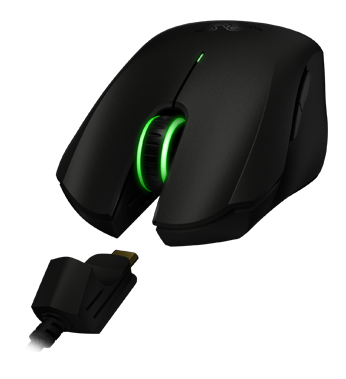Product Review: Razer Orochi
- Claire is right handed, but she likes to switch mousing hands in order to minimise her risk of RSI or OOS. Therefore, the new mouse needed to be ambidextrous.
- The main thing she didn’t like about the Logitech M510 was the weight – I had to admit, it was much heavier than the Microsoft corded variety – so lightweight joined the list of requirements.
- Finally, with Claire’s preference for swapping mousing hands, I was definitely looking for a wireless variety.
 After some searching, I came upon the Razer Orochi mouse. Though this mouse is more typically aimed at gamers, the price and build makes it well suited to a business environment, and it met all the requirements on our list.
After some searching, I came upon the Razer Orochi mouse. Though this mouse is more typically aimed at gamers, the price and build makes it well suited to a business environment, and it met all the requirements on our list.
The Orochi is easy on the eye, with a matte black colour and sleek design. Since all computer gear seems to come in black nowadays, it fits in very well on the computer desk. The Orochi also features an ambidextrous design, which means that left-handed people should have no trouble taking it on as their mouse of choice. Being small and lightweight, along with slippery footpads, means that the mouse can be used all day without fatiguing your hand from prolonged use.
The Orochi also has a very reasonable battery life. Two standard AA batteries will give you approximately 30 hours of intensive use, or 3 months of regular use.
In terms of connectivity, the Orochi can be used either wired (via a detachable adapter cable) or wireless (via a Bluetooth connection), which means that it can be easily switched between your desktop in the office and your laptop/tablet in the field. The mouse performs well under both connection options.

Razer tend to make a big deal of their software, and the Orochi’s sister software is no different. The Orochi works with Razer’s Synapse 2.0 software, which is basically management software for a personal, cloud-based user profile. This means your individual settings can be saved and used elsewhere (for example, synched between your laptop and office PC), and driver or firmware updates can be automatically downloaded when required. I’ve never been particularly excited about these types of software, but the feature is nonetheless a handy one to have in your arsenal.
I set Claire up with the mouse and approached her for feedback after a couple months. She’s very happy with the mouse and is glad I suggested it to her. Overall, Claire and I would both recommend the Razer Orochi to anyone looking for a high-end, lightweight, ambidextrous, wireless mouse!

